Drawn to the Future, a major exhibition on visualization technology featuring leading pioneers in architecture and engineering tech, highlights how our experience of our cities and buildings will rapidly change.
Images of the city have always wielded psychological, emotional and political power. Anyone brought up on a diet of Hollywood movies and US TV shows will have had that uncanny experience as a first-time visitor to a US city - a sense of déjà vu, the feeling of being on a movie set, in a story. I took the Blade Runner cityscape so seriously as a student in New York in 1983, that after a late-night showing of the film, I went into a phone box and rang the number dialed by Harrison Ford on the 'video screen' (555-7563 in case you're interested). The decay of Ridley Scott's dystopian future spilled over into the rodent-rich, un-gentrified, occasionally threatening Lower East Side of the time.
The Drawn to the Future exhibition at The Building Centre in London, showcases the new image technologies used by architects and engineers, games makers and movie concept artists, to visualize future cities.
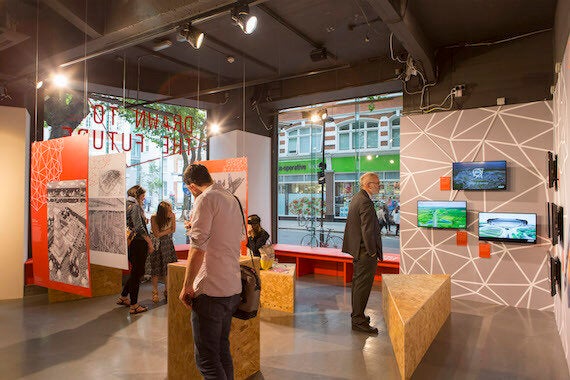
(Courtesy of The Building Centre)
Soluis (one of the many UK companies in the show pioneering leading image tech), features their immersive dome which is akin to being inside an enormous eye.
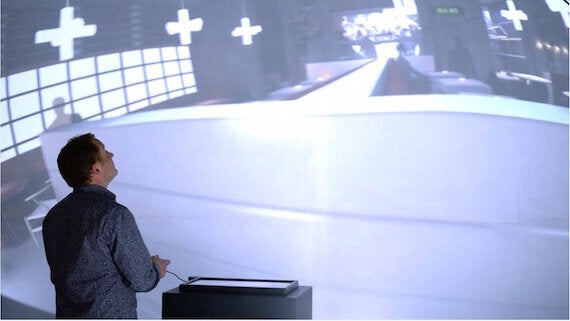
(Courtesy Soluis)
Visitors can move around a restored version of Charles Rennie Mackintosh's masterpiece, the Glasgow School of Art Library. Their technology is also used by Radisson Red Hotels, in which the Soluis immersive tech enables you to experience the hotel room virtually and to select the furniture.

(Courtesy Soluis)
This immersive image technology which places us 'elsewhere', has potentially therapeutic uses. Doing research for the show I talked to Soluis' Fergus Bruce who revealed,
one of the most unusual responses was from a psychologist, who suggested VR technology like the dome could be used to help place users in someone else's shoes, and that this could be of huge benefit in the treatment of people where empathy and understanding the perspective of others presents difficulties.
In the future, using such an immersive dome, perhaps city planners, architects and developers might get a more immersive sense of what it's actually like for someone to live in one of their buildings or city developments before they build it.
One fascinating sub-plot to the exhibition is how these new technologies may enable us to actively engage in the development of our cities. At the least they will make us think about the forces that are shaping our urban landscapes.
Cityzenith's 5D Smart City image technology gathers together the huge amount of data flowing around our cities that's produced by us in our everyday activities and enables us to see it in an interactive 3D interface. From an idea by Remi Arnaud, former lead developer of Google Earth, it's already being used in Amsterdam, Barcelona, and San Francisco. The interface enables the user to use raw urban data as the building bricks for solutions to pollution, transport, education, better use of energy resources. Such image technologies have the potential to redistribute the power of image-making away from experts, giving people the power to draw for themselves a different picture of our future.
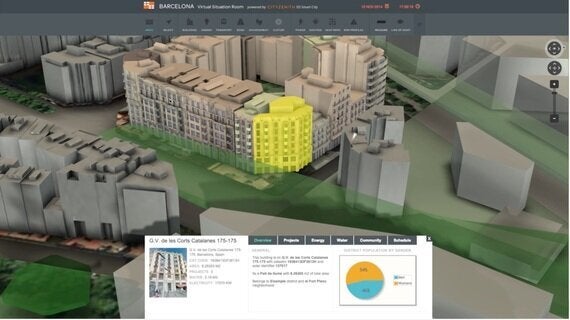
(Screen grab from Cityzenith video)
Chatting with Drawn to the Future curator Lewis Blackwell, he told me,
what's interesting is the kinds of information virtual imagery will contain, how we interact with them and how seamlessly these images will interact with us.
A powerful example of image technologies' power to alter the future was the ReMap Lima project conducted in Peru by the Bartlett's Development Planning Unit with the Center for Advanced Spatial Analysis, collaborating with local groups and citizens. Using a cameras on a drone, then printing a 3D map filled out with information gathered by marginalized local people, they were able to map areas not represented on official maps. It's not just that your poverty means you're forgotten, it's that officially your space doesn't exist.
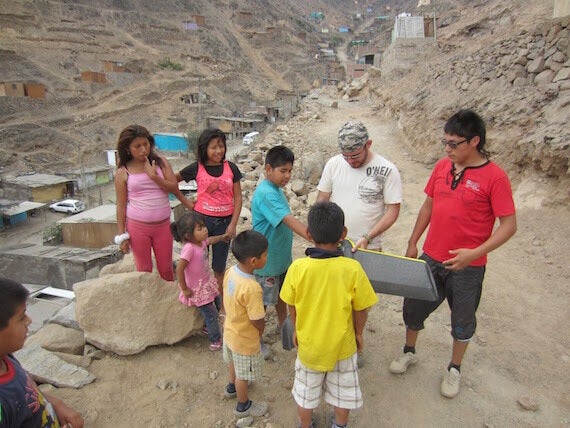
(Courtesy CASA/ReMap Lima)
The maps enabled local citizens to see encroaching development and land traffickers and visualized a concrete image of their world around which they could negotiate with local bodies and institutions. Those maps are images that shift even a little, the relations of power. Rita Lambert from the group at the Bartlett believes that these maps provided an invaluable resource for such marginalized communities,
the informal urbanization occurring at a fast pace is a result of the lack of housing policies and affordable land for the urban poor in Lima. These settlements which tend to occupy steep slopes and therefore high-risk areas, are not recognized by the state and do not therefore make it onto any of the official maps.
From giant cathedrals to soaring skyscrapers, from monuments to statues, cities draw pictures of divine and secular power. The monumentalism of these buildings symbolize the stability, permanence and authority of their power. But John Cook's project The Cambedoo Solar Estate explores the power of an architecture built to decay in specific ways. Winner of this year's Visualising the Future of the City competition held by The Royal Institute of British Architects, Cook's visionary buildings decompose and 'reassemble' with a different purpose. The Cambedoo Solar Estate begins as an a solar energy plant and epic wine-making facility in the desert.
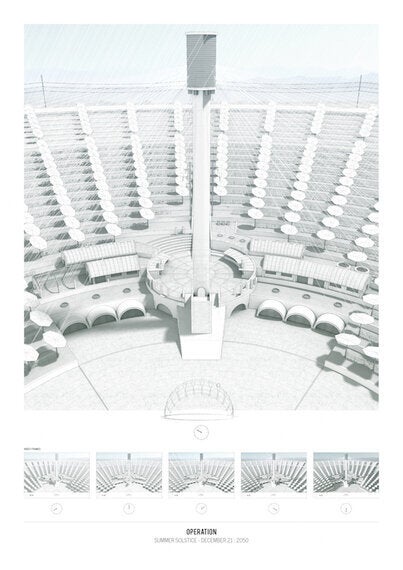
(Courtesy John Cook)
The building regenerates as it degenerates, as the original solar/vinery technology becomes redundant, the building's decay reconstructs itself as something else. Cook explained to me,
When these buildings become abandoned or fall into disrepair, the design and careful material selection inform a sort of 'choreographed' degradation. As certain building parts collapse and disintegrate, the hidden astronomical instruments are revealed, and the building enters its final use of 'astronomical observatory'.
This speculative vision is a celebration and engagement with the cycle of life-and-death. It's not just an antidote to the hubris with which we as human beings have already spent the planet's future. John Cook's extraordinary visualization models a way in which images are used to create a better, more imaginative future. While the streets of Blade Runner are seductively moody and atmospheric, I wouldn't want to live there.
Drawn to the Future runs at The Building Centre, London until October 3, and you can find interviews from the contributors here and information on panel events and talks. John O'Reilly helped research the show.